See Jupiter and its Moons Through Telescope
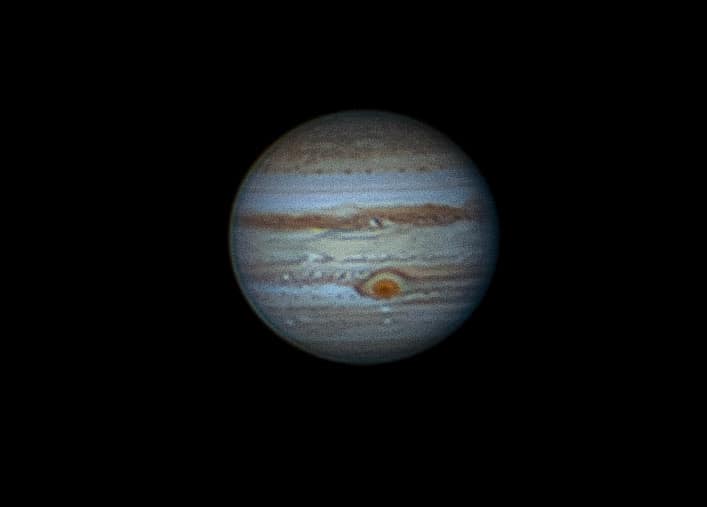
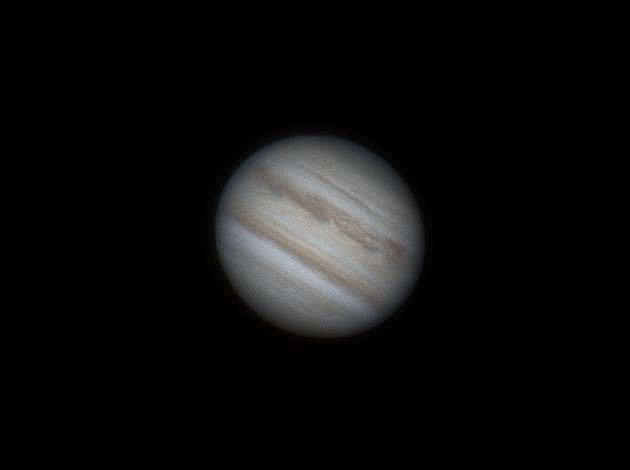
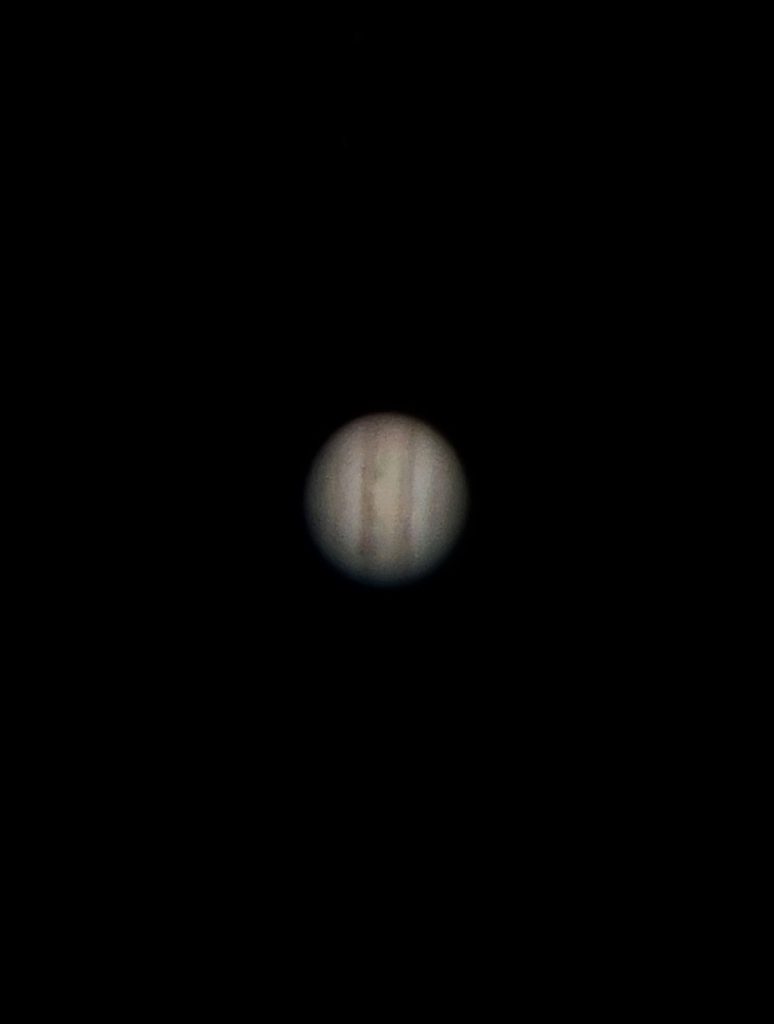
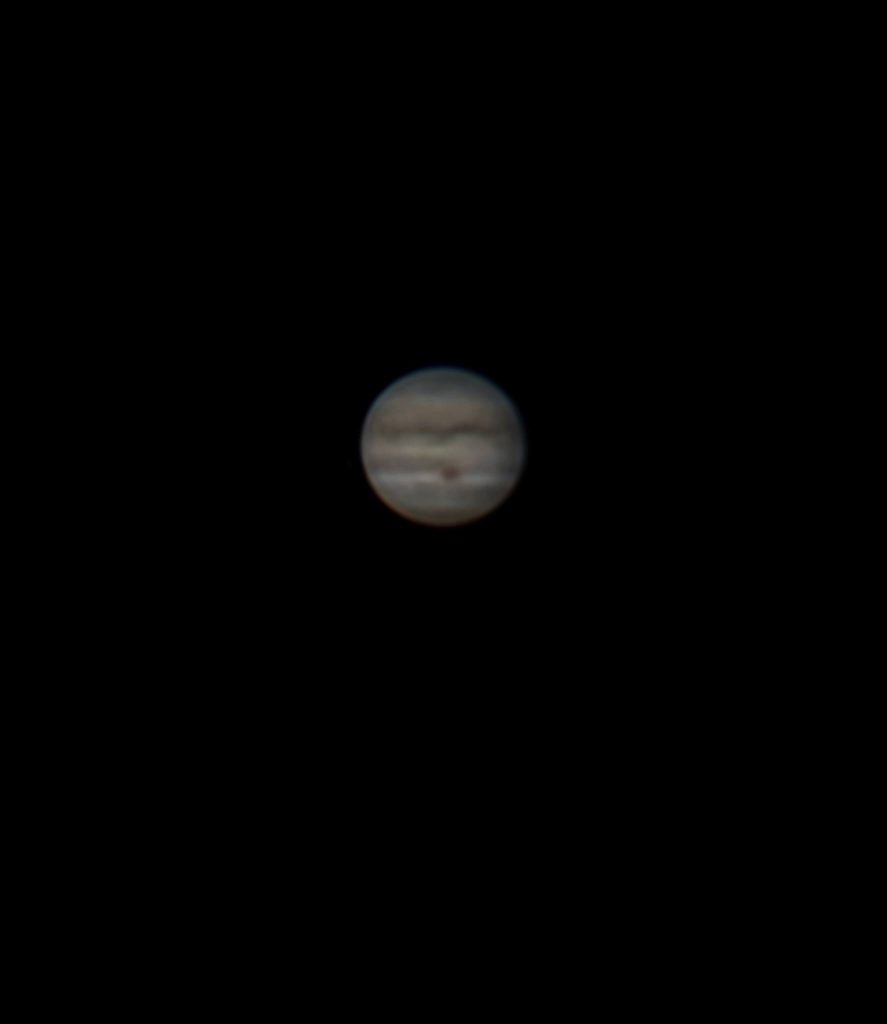
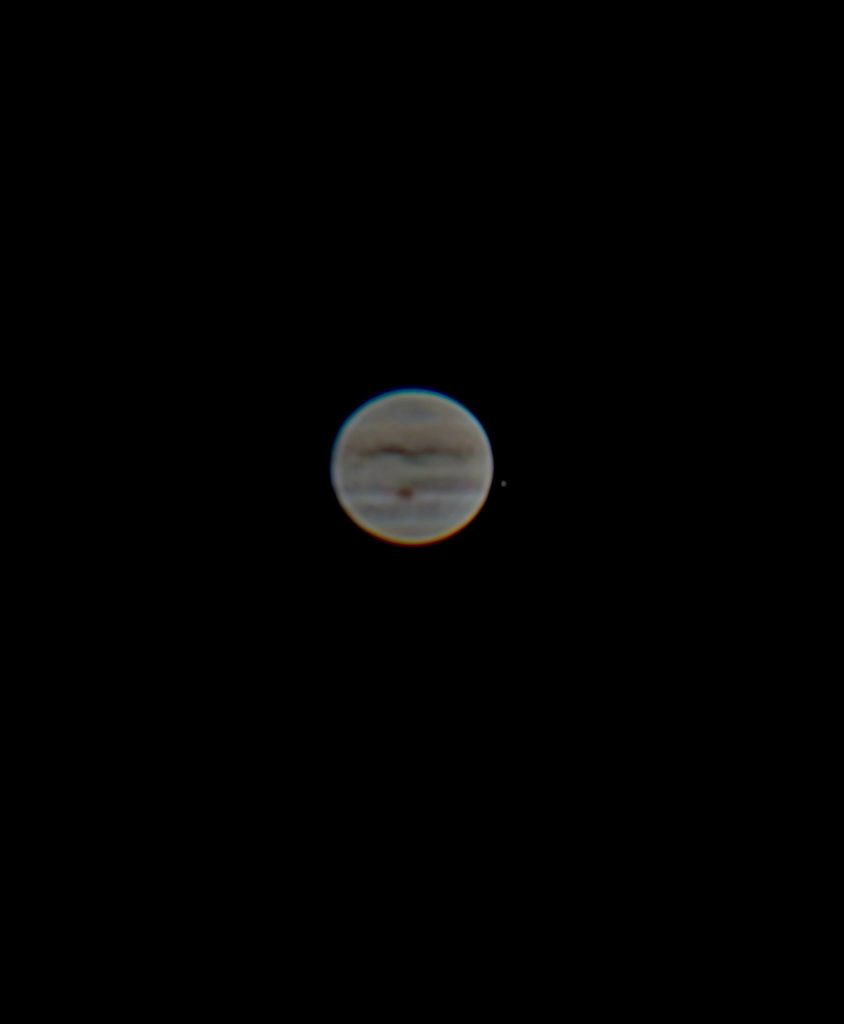
Jupiter is one of the brightest objects in the night sky. Jupiter can be observed with a telescope to discern its disk and atmospheric details. A telescope with a lens diameter of at least 60mm is sufficient to reveal Jupiter’s disk, major cloud bands, and up to four of its largest moons: Io, Europa, Ganymede, and Callisto. Larger telescopes with an aperture of 150mm or 6 inches can provide more detailed views, such as the Great Red Spot and finer cloud band structures. Magnification power of around 100x to 200x is required to see Jupiter clearly. Filters and techniques like using a Barlow lens can enhance contrast and magnification, providing better views of Jupiter’s details.
Jupiter appears as a massive disk with distinct and vibrant features when viewed through a telescope. Jupiter looks like a bright white or yellowish disc with one or two brownish bands at low magnification. Jupiter appears more oval-shaped due to its rapid rotation as magnification increases. Higher magnifications reveal more detail in Jupiter’s cloud bands, displaying a stunning array of colors. The Great Red Spot is a persistent anticyclonic storm. Red Spot is a prominent feature visible through a properly focused telescope. Up to four of Jupiter’s largest moons appear as bright points of light near the planet.
The best telescope to see Jupiter is the Celestron NexStar 130SLT Computerized Telescope. It offers a balance of aperture size, magnification power, optical quality, ease of use, and affordability. The telescope features a 130mm (5.1 inches) aperture lens for high resolution and magnification. It has a maximum magnification power of 307x and comes with a 32mm eyepiece. The optical quality provides clear views of Jupiter’s cloud bands, the Great Red Spot, and its four largest moons. The computerized system makes it easy to locate and track Jupiter’s position in the night sky.
To find Jupiter with a telescope, first determine its position in the night sky using planetarium software, websites, or a sky map. Look for constellations Pisces or Aquarius, as Jupiter will be nearby during its opposition. Choose a clear, dark night with minimal moonlight and atmospheric disturbance for viewing. Set up a telescope with a minimum aperture of 60 mm (2.4 inches) and a focal length of at least 700 mm (27.5 inches). Start with a low magnification of around 50-70x to get a wide view of Jupiter and its moons. Increase magnification to 100-150x to see more details of Jupiter’s surface and moons. Utilize colored filters to enhance contrast on Jupiter’s cloud bands for clearer views. Observe Jupiter when it is at its highest point in the sky, around midnight, to reduce atmospheric distortion. Use a sturdy tripod to minimize telescope movement for a clear view. Allow your telescope to cool down to the ambient temperature to reduce thermal distortion.
Can you see Jupiter with a telescope?
Yes, you can see Jupiter with a telescope. Jupiter is one of the best celestial objects to observe in the night sky. Small telescope with a lens diameter of at least 60mm can reveal Jupiter’s disk, major cloud bands, and up to four of its largest moons: Io, Europa, Ganymede, and Callisto. Larger telescopes with an aperture of 150mm or 6 inches can provide more detailed views, such as the Great Red Spot and finer cloud band structures.
To see Jupiter clearly through a telescope, you need a magnification power of around 100x to 200x. With this power, you can observe Jupiter’s disk, which appears as a bright, creamy-yellowish color, and its cloud bands. On a clear night with good seeing conditions, you may spot the Great Red Spot, a persistent anticyclonic storm on Jupiter. Filters and techniques like using a Barlow lens can enhance contrast and magnification, providing better views of Jupiter’s details.
For the best viewing experience, observe Jupiter at opposition, which occurs every 13 months when Earth passes between the Sun and Jupiter, making Jupiter at its brightest and closest to Earth.
Can Jupiter Red Spot be seen with a telescope?
Yes, Jupiter’s Great Red Spot can be seen with a telescope. Telescope with an aperture of at least 4 to 6 inches is required to see the red spot on Jupiter. The Great Red Spot is a massive storm larger than Earth. Red Spot appears as an oval-shaped feature in Jupiter’s southern hemisphere, with its color varying from reddish to pale gray depending on the year. This anticyclonic storm rotates counter-clockwise, taking approximately six Earth days to complete one rotation.
A magnification range of 100x to 200x is recommended for optimal viewing of the Red Spot. The best time to observe the spot is when it is directly facing Earth, allowing for a more detailed view. Given the challenges in predicting the ideal viewing times, amateur astronomers can benefit from tracking websites and apps that provide alerts for such opportunities.
Can you see Jupiter rings with a telescope?
Yes, Jupiter’s rings can be seen through a telescope, but not with most ground-based or large amateur telescopes. The rings are too dim and require a more powerful instrument for observation.
Even with a high-quality telescope with a large aperture (at least 6-8 inches or 15-20 cm) and high magnification power (around 200-300x), the rings of Jupiter will appear as a thin, diffuse halo around the planet. The rings are composed of dust and debris from Jupiter’s moons and nearby asteroids, and ideal viewing conditions are necessary to observe this faint, hazy ring system surrounding the planet.
Can Jupiter be seen at night without a telescope?
Yes, it is possible to see Jupiter at night without a telescope. Jupiter is one of the brightest celestial objects in the night sky, often surpassed only by the Moon and Venus in terms of brightness. Jupiter appears as a distinct, cream-colored point of light that remains steady, unlike stars that twinkle. Jupiter is one of the five planets, including Mercury, Venus, Mars, and Saturn, that can be seen with the naked eye, given the right conditions.
Jupiter’s visibility is at its peak a couple of months before and after opposition. Opposition is the point in Jupiter’s orbit when it is closest to the Sun and Earth, making it appear brighter and larger in the night sky. Jupiter is easily observable without any optical aid during opposition. While Jupiter is visible to the naked eye, its moons require binoculars or a small telescope to be seen.
What does Jupiter look like with a telescope?
Gazing upon Jupiter through a telescope reveals a breathtaking, massive disk teeming with distinct and vibrant features. At low magnification (30-50x) Jupiter looks like a bright white or yellowish disc, with one or two brownish bands gracing its equator. These bands are just the beginning of the planet’s mesmerizing cloud patterns.
As magnification increases (around 150x) Jupiter starts to look more squashed or oval-shaped, a result of its rapid rotation. Higher magnifications reveal more detail in Jupiter’s cloud bands, displaying a stunning array of colors like lemon, orange, brown, and reddish tones. These bands, known as cloud belts, are visible and alternate between lighter and darker shades of yellow, brown, and white. They are created by strong winds in Jupiter’s atmosphere, which can reach speeds of up to 644 km/h (400 mph) and are 10,000 to 20,000 km (6,200 to 12,400 miles) wide.
Through a properly focused telescope, one would see the Great Red Spot, a prominent feature on Jupiter. This reddish oval on Jupiter’s cloud tops is a persistent anticyclonic storm that has been raging for centuries, measuring approximately 25,000 km (15,500 miles) in diameter.
Up to four of Jupiter’s largest moons (Io, Europa, Ganymede, Callisto) appear as bright points of light near the planet when looking thru a telescope. These moons, which look small but are massive in reality, orbit their home planet in an ever-changing dance. Their positions relative to Jupiter change nightly, and on some occasions, their shadows may be visible crossing Jupiter’s disc.
The polar regions of Jupiter appear as hazy, white areas due to the presence of ammonia ice clouds. The cloud bands’ texture and pattern look like wispy, feathery structures. Jupiter’s rotation causes the cloud bands to appear to move as the planet rotates, offering a dynamic viewing experience.
A telescope with a diameter of at least 60 mm (2.4 in) allows observation of the Great Red Spot and Jupiter’s four largest moons. A moderate-sized telescope (6-8 inches in diameter) shows Jupiter’s disk as approximately 30-40 arcseconds in diameter, about 1/3 the diameter of the full Moon.
Jupiter’s atmosphere is composed mostly of hydrogen and helium, which scatters sunlight, giving it a cloudy appearance. Jupiter has a high albedo (reflectivity) of around 0.52, meaning it reflects about 52% of the incident sunlight. This high reflectivity and massive size make Jupiter one of the brightest objects in the night sky, outshining most stars.
What is the best telescope to see Jupiter?
The best telescope to see Jupiter is the Celestron NexStar 130SLT Computerized Telescope. This telescope offers an exceptional balance of aperture size, magnification power, optical quality, ease of use, and affordability, making it an ideal choice for both beginners and experienced astronomers.
The Celestron NexStar 130SLT features a 130mm (5.1 inches) aperture lens, which is crucial for gathering light and providing high resolution and magnification. A larger aperture is essential for a clearer view of Jupiter’s details, such as its cloud bands and the Great Red Spot. For an even more detailed view, apertures of 6 inches (150mm) or larger are recommended.
NexStar 130SLT boasts a maximum magnification power of 307x. High magnification power is necessary to see Jupiter and its features clearly. The telescope comes with a 32mm eyepiece, providing a wide-angle view, but other eyepieces with different magnifications can be used to get a closer look at Jupiter’s details.
The optical quality of the Celestron NexStar 130SLT is exceptional. Its 130mm aperture lens provides a clear view of Jupiter’s cloud bands, the Great Red Spot, and its four largest moons. Quality optics are essential for high contrast views, which bring out the details on the planets.
The Celestron NexStar 130SLT is user-friendly. Its computerized system allows you to easily locate and track Jupiter’s position in the night sky, making it perfect for beginners. The computerized go-to mounts are especially helpful for finding and tracking Jupiter, while a sturdy equatorial mount is important for high magnification planetary viewing.
The Celestron NexStar 130SLT is affordable, offering high-quality views without breaking the bank. Other frequently recommended models for viewing Jupiter include the Celestron NexStar 8SE, Orion SkyQuest XT8 Dobsonian, and Celestron CPC Deluxe 1100 EdgeHD.
The Sky-Watcher Evostar 80mm refractor is a good option in this aperture range. For those looking for a computerized option, the Celestron NexStar 130SLT Computerized Telescope (130 mm aperture, 650 mm focal length) is an excellent choice. The Meade Instruments Infinity 102mm AZ Refractor Telescope (102 mm aperture, 600 mm focal length) and the Orion 8945 SkyQuest XT8 Classic Dobsonian Telescope (203 mm aperture, 1200 mm focal length) are highly recommended to observe Jupiter.
What telescope lens to see Jupiter?
To observe details on Jupiter, you need around 60x-130x magnification. The general guidance is to aim for around 25x magnification per inch of aperture when observing planets like Jupiter. A 4-inch telescope would use 100x-200x magnification. Using too much magnification without a large enough aperture can degrade the view.
Refractor telescope with an achromatic lens or a reflector telescope with a parabolic mirror is ideal for viewing Jupiter. The focal length of the lens or mirror plays a significant role in your viewing experience. A lens or mirror with a focal length of around 700 mm to 1,400 mm (27.6 inches to 55.1 inches) will provide a good view of Jupiter.
What is the best telescope filter for Jupiter?
The best telescope filter for Jupiter is a methane (CH4) filter. This specific filter is designed to enhance your view of Jupiter’s cloud bands, allowing you to see them more clearly and in greater detail.
A methane filter operates by working with specific wavelengths of light. It has a wavelength of around 890 nanometers (nm) and a bandwidth of approximately 10-20 nm. This range is ideal for blocking the majority of visible light that is reflected off Jupiter’s bright cloud tops. The filter allows dimmer, methane-absorbed light from Jupiter’s deeper atmosphere to pass through, which significantly improves the contrast and visibility of the planet’s features.
One of the most notable benefits of using a methane filter is the enhancement of Jupiter’s cloud bands. These bands become more pronounced and visible, allowing observers to see the intricate details and patterns within them. The filter’s ability to block wavelengths of light and enhance others results in a higher contrast view of the cloud bands, making them stand out against the backdrop of the planet.
Methane filter helps you see is Jupiter’s Great Red Spot. This iconic storm becomes more vivid and defined when viewed through a methane filter. The deeper red color of the spot is accentuated, making it a truly breathtaking sight for any observer.
Methane filter allows you to explore Jupiter’s atmospheric features in greater detail. Elements such as vortices, waves, and hazes, which are often obscured by bright cloud tops, become more visible. This makes a methane filter an essential tool for both planetary observers and astrophotographers seeking to capture detailed images of Jupiter’s dynamic atmosphere.
You can use other colored filters like #58 green or #82A blue to enhance contrast on Jupiter’s cloud bands.
How to find Jupiter with a telescope
To find Jupiter with a telescope, follow the steps listed below.
- Determine Jupiter’s position in the night sky using planetarium software, websites, or a sky map.
- Look for constellations Pisces or Aquarius, as Jupiter will be nearby during its opposition.
- Choose a clear, dark night with minimal moonlight and atmospheric disturbance for viewing.
- Set up a telescope with a minimum aperture of 60 mm (2.4 inches) and a focal length of at least 700 mm (27.5 inches).
- Start with a low magnification of around 50-70x to get a wide view of Jupiter and its moons.
- Use an eyepiece with a focal length of 20 mm (0.8 inches) to achieve the initial magnification.
- Increase magnification to 100-150x to see more details of Jupiter’s surface and moons.
- Look for Jupiter’s four largest moons: Io, Europa, Ganymede, and Callisto.
- Use higher magnifications up to 200x to observe Jupiter’s cloud bands and the Great Red Spot.
- Utilize colored filters to enhance contrast on Jupiter’s cloud bands for clearer views.
- Observe Jupiter when it is at its highest point in the sky, around midnight, to reduce atmospheric distortion.
- Use a sturdy tripod to minimize telescope movement for a clear view.
- Allow your telescope to cool down to the ambient temperature to reduce thermal distortion.
- Use a moon filter or a neutral density filter to decrease Jupiter’s brightness and see more surface details.
Determine Jupiter’s position in the night sky. Utilize planetarium software, websites, or a sky map to ascertain Jupiter’s celestial coordinates, which include its right ascension and declination. Keep an eye out for the constellations Pisces or Aquarius, as Jupiter will be in close proximity to these constellations during its opposition.
Choosing the right time and conditions is crucial for a successful viewing experience. Aim for a clear, dark night with minimal moonlight and atmospheric disturbance. Jupiter is best visible when it’s at opposition, an event that takes place every 13 months.
Setting up your telescope is the next step. Opt for a telescope with a minimum aperture of 60 mm (2.4 inches) and a focal length of at least 700 mm (27.5 inches). Both refractor and reflector telescopes with high-quality lenses or mirrors are suitable for the task.
Using the right magnification is essential to see Jupiter and its details clearly. Begin with a low magnification of around 50-70x to obtain a wide view of the planet and its moons. Achieve this magnification by using an eyepiece with a focal length of 20 mm (0.8 inches). To observe more detailed views of Jupiter’s surface and moons, increase the magnification to 100-150x.
With a magnification power of 100-150x, you can look for Jupiter’s four largest moons: Io, Europa, Ganymede, and Callisto. These moons will appear as small, bright dots near Jupiter’s disk.
To observe Jupiter’s details, such as cloud bands and the Great Red Spot, use higher magnifications up to 200x. Colored filters can enhance the contrast on Jupiter’s cloud bands, providing a clearer view of the planet’s features.
Optimizing viewing conditions will further enhance your experience. Observe Jupiter when it is at its highest point in the sky, around midnight, to reduce atmospheric distortion. Utilize a sturdy tripod to minimize telescope movement and ensure a clear view. Allow your telescope to cool down to the ambient temperature to reduce thermal distortion. Additionally, use a moon filter or a neutral density filter to decrease Jupiter’s brightness and see more details on its surface.
